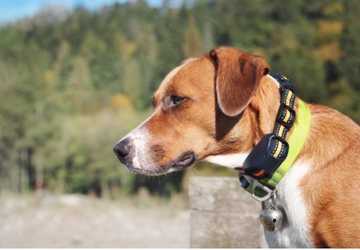When to replace a pet collar is a problem many pet custodians contemplate. Collars are quintessential for security and identification, yet their durability is finite. Over time, attrition can subvert their efficacy and comfort. Comprehending when to replace a pet collar can ensure your pet remains secure and at ease.
Signs Your Pet's Collar is Worn
One of the quintessential indicators of when to replace a pet collar is overt degradation. Here are some symptoms to discern:
Fraying or Tearing: If you observe frayed edges or ruptures, it's a definitive sign that your pet's collar needs replacement.
- Fading Color: A pallid collar might signify that the material has enfeebled.
- Stretched Out: Collars that have elongated may no longer fit appropriately.
- Broken Buckles or Clasps: Scrutinize for any impairment to the buckles or clasps, as these are vital for maintaining the collar secure.
- Rusty or Damaged Metal Parts: If the metallic components of the collar are oxidized or compromised, it's time to procure a new one.
Health-Related Indicators

Occasionally, the signs your pet's collar is worn are somatic. Here are some health indicators to be vigilant about:
- Skin Irritation: If your pet's epidermis is inflamed or irritated around the collar area, it could be due to a deteriorated or ill-fitting collar.
- Hair Loss: Alopecia or thinning fur around the neck can indicate that the collar is excessively tight or abrasive.
- Allergic Reactions: If your pet manifests an allergic reaction, it might be due to the materials in the antiquated collar.
Tips for Choosing a New Pet Collar
Once you've identified the signs that your pet's collar is worn, the next step is to choose a new collar.
Substance Considerations
In procuring a novel pet collar, it is imperative to meticulously deliberate upon the constituent substance. An array of disparate materials proffer a multitude of variegated advantages:
- Nylon: Tenacious and lightweight, ideal for quotidian use.
- Leather: Robust and enduring, though it might be heftier and necessitate more upkeep.
- Neoprene: Supple and comfortable, excellent for pets with sensitive dermis.
Meticulous Calibration
An impeccably tailored neckband is paramount for the comfort and safety of your cherished companion. When selecting a novel pet collar, ensure meticulous calibration as follows:
- Quantify Cervical Circumference: Employ a supple, flexible tape measure to obtain a precise circumferential quantification of your pet's neck.
- Bifurcated Digital Rule: Inserting two digits between the neckband and your pet's cervical region is essential.
Bands: Opt for neck bands with adjustable dimensions to accommodate physiological growth or variations in mass.
Safety Features
When choosing a new pet collar, consider safety features that can provide augmented security:
- Breakaway Collars: These are designed to release under pressure, preventing asphyxiation if the collar gets tangled in something.
- Reflective Materials: Reflective collars can enhance visibility for pets that traverse at night.
- ID Tags and Microchips: Ensure an ID tag is secure, and consider having your pet microchipped for added safety.
Preservation Stratagems for Your Pet's Neckband
Consistent upkeep is of the utmost importance to extend the longevity of your pet's neckband and ensure its perpetual safety and comfort. Herein are some preservation stratagems:
- Routine Ablution: Based on the constituent material, neckbands should undergo regular cleansing to eradicate accumulated filth and microbial contaminants.
- Vigilant Examination for Deterioration: Conduct frequent inspections for indications of wear, such as unravelling, elongation, or impairment to fastening mechanisms.
- Periodic Adjustment: Continuously ensure the neckband maintains an optimal fit as your pet matures or undergoes weight variations.
When to Replace Pet Collar: Frequency

Knowing when to replace pet collar depends on various factors, including the collar's material and your pet's activity level. Generally, it's prudent to inspect the collar every few months and replace it at least once a year or more frequently if you notice any signs your pet's collar is worn.
Types of Pet Collars and Their Benefits
Each type offers unique advantages and serves distinct purposes.
Flat Collars
Flat collars are the quintessential type of collar utilized for quotidian activities. They are typically fabricated from nylon or leather.
- Versatility: Suitably adaptable for a plethora of pets and myriad activities.
- Variety: Proffered in an extensive array of chromaticities, motifs, and configurations.
- Ease of Use: Uncomplicated to don and disrobe.
Martingale Neckbands
Martingale neckbands are meticulously engineered for canines predisposed to extricating themselves from conventional collars. They provide a harmonious balance between comfort and control.
- Safety: Diminishes the peril of the canine eluding capture.
- Control: Affords mild correction without inducing asphyxiation.
- Adjustability: Capable of modulation to ensure a secure yet comfortable fit.
Harnesses
Harnesses are an alternative to traditional collars, offering augmented control and diminishing strain on the pet's cervical region.
- Support: Allocates pressure uniformly across the pectoral region and scapulae.
- Control: Exquisite for conditioning and promenading pets inclined to tug.
- Comfort: Mitigates the likelihood of trauma to the cervical and tracheal areas.
Head Collars
Head collars, also called halters, are designed to give the owner more dominion over the pet's head and direction.
- Control: Affords paramount command over the pet's locomotion.
- Training: Highly efficacious for inculcating discipline in pets predisposed to pulling.
- Safety: Minimizes the risk of cervical traumas.
Advanced Features in Modern Pet Collars
When choosing a new pet collar, contemplate advanced features that can enhance safety and functionality.
GPS Tracking Collars
Geospatial Positional Systems tracking collars are endowed with advanced technological apparatuses that capacitate custodians to meticulously monitor the precise whereabouts of their domesticated companions in a contemporaneous temporal framework.
- Safety: Bestows tranquillity by providing constant awareness of the pet's whereabouts.
- Technology: Frequently accompanied by mobile applications for effortless tracking.
- Durability: Engineered to endure diverse meteorological conditions and rigorous activities.
Smart Collars
Smart collars offer a plethora of functionalities, ranging from activity surveillance to comprehensive health monitoring.
- Health Monitoring: Monitors vital signs and activity metrics with precision.
- Alerts: Alerts regarding health anomalies or unusual activity are sent to the owner's smartphone.
- Convenience: Often integrates features such as temperature alerts and virtual perimeters.
Reflective and LED Collars
Reflective and LED collars are meticulously crafted to augment visibility during twilight conditions.
- Visibility: Enhances safety during nocturnal excursions.
- Durability: Fabricated with resilient materials capable of withstanding regular use.
- Adjustability: Available in many sizes and designs to suit various pets.
Conclusion
Understanding when to replace a pet collar is indispensable for maintaining your pet's safety and comfort. By regularly scrutinizing for signs your pet's collar is worn and choosing a new pet collar with diligence, you can ensure your furry companion remains content and healthy. Always prioritize your pet's well-being by selecting the right materials, ensuring a proper fit, and considering safety features. With these tips, you'll be well-equipped to keep your pet secure and comfortable with a collar that meets their needs.
